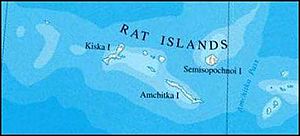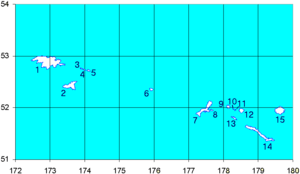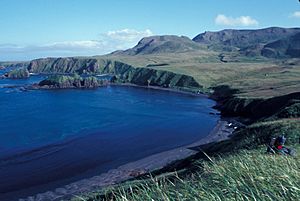Rat Islands facts for kids
The Rat Islands are a group of American volcanic islands in southwestern Alaska. They are part of the Aleutian Islands. These islands are located between Buldir Island and the Near Islands to the west. To their east are Amchitka Pass and the Andreanof Islands.
The largest islands in this group are, from west to east:
- Kiska
- Little Kiska
- Segula
- Hawadax (also known as Kryssei)
- Khvostof
- Davidof
- Little Sitkin
- Amchitka
- Semisopochnoi
The total land area of the Rat Islands is about 934.594 square kilometers (360.849 square miles). No one lives on any of these islands.
Why the Name "Rat Islands"?
The name Rat Islands comes from a Russian name given by Captain Fyodor Petrovich Litke. He visited the Aleutian Islands in 1827 during a trip around the world. The islands got this name because rats accidentally arrived on Hawadax Island (which was then called Rat Island) around 1780.
In 2009, a program helped remove the rats from Hawadax Island. This island is now believed to be free of rats. In 2012, its name was officially changed to Hawadax Island. This change helped to remove the old name's connection to rats.
Earthquakes and the Islands
The Rat Islands often experience earthquakes. This is because they sit on the border of two huge pieces of the Earth's crust, called tectonic plates. These are the Pacific and North American plates. When these plates move, it causes earthquakes.
One of the biggest earthquakes ever recorded happened here. It was the 1965 Rat Islands earthquake, which had a very strong magnitude of 8.7.
See also
 In Spanish: Islas Rata para niños
In Spanish: Islas Rata para niños




